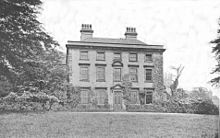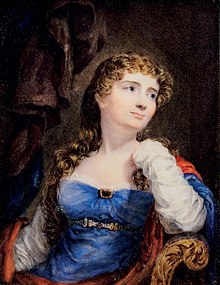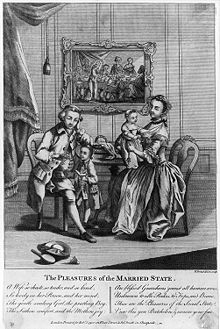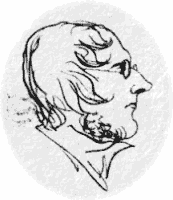The Tenant of Wildfell Hall
[4] Another possible source for The Tenant is the story of Mrs Collins, the wife of a local curate, who in November 1840 came to Anne's father Patrick Brontë seeking advice regarding her alcoholic husband's abusive conduct.Huntingdon's son Arthur becomes addicted to alcohol through his father's efforts, but Helen begins to add to his wine a small quantity of tartar emetic, "just enough to produce inevitable nausea and depression without positive sickness".Joshi concludes that Gilbert is "tottering toward a new form of masculinity" together with Jack Halford, his close friend, by exchanging[a] confidences and, by learning to communicate and reveal emotions, doing what is considered to be feminine, he can redeem himself, become a new man and a worthy husband of Helen.[14] Josephine McDonagh believes that the theme of displacement is underlined by the title of the novel: Helen is the tenant, not an owner-occupier, of Wildfell Hall, the place of her birth, which was bequeathed to a male descendant, her brother.Such "borrowed voices" may denote the displacement of the main heroes[2] – Gilbert, being a well-educated man with high ambitions for some "great achievements", is forced to take over his father's farm, and Helen, being a runaway wife, can call neither her home nor her name her own.Her alternating freedom to paint and inability to do so on her own terms not only complicate Helen's definition as wife, widow, and artist, but also enable Anne Brontë to criticize the domestic sphere as established by marriage and re-established with remarriage.Resembling the time of Arthur's courtship, when Helen's portraits of him betrayed her affection, artwork once again serves the autobiographical role during her meetings with Gilbert – the painting of Wildfell Hall deceptively labelled "Fernley Manor" discloses her precarious position as a runaway wife.[14] Anne's portrayal of Arthur Huntingdon deflates the Byronic cult – while witty, adventurous and handsome, he is not endowed with intellectual gifts, nor even vitality, famously exhibited by Heathcliff, and has nothing of the fundamental goodness that finally redeemed Rochester.Analyzing the lack of sense and reason amongst males as the consequence of value-system based on the worship of machismo, Anne depicts the pathetic end of her main hero, brought on by his drinking habits.The character of Helen Graham may have been inspired by Anna Isabella Milbanke, the wife of Lord Byron, who also thought at first that her religious obligation was to improve her husband's behavior, but very soon she was disillusioned, separated from him and raised their child alone.The eternal struggle between good and evil is emphasised by heavy use of biblical references: sinners who repent and listen to reason are brought within the fold, while those who remain stubborn tend to meet violent or miserable ends.Jacobs concludes that both Emily and Anne seemed to find it necessary, in approaching subjects that were considered to be controversial, to use the voice of a male narrator, appropriating, delegitimizing and even ridiculing his power, before telling anti-patriarchal truth.The fault of the book is coarseness—not merely that coarseness of subject which will be the stumbling-block of most readers, and which makes it utterly unfit to be put into the hands of girls..." Despite this, he believed that: "[English] society owes thanks, not sneers, to those who dare to shew her the image of her own ugly, hypocritical visage".There is power, effect, and even nature, though of an extreme kind, in its pages; but there seems in the writer a morbid love for the coarse, not to say the brutal; so that his level subjects are not very attractive, and the more forcible are displeasing or repulsive, from their gross, physical, or profligate substratum.There is a coarseness of tone throughout the writing of all these Bells [Charlotte, Emily and Anne Brontë], that puts an offensive subject in its worst point of view, and which generally contrives to dash indifferent things".[30] The Examiner, while praising all Brontës as "a hardy race", who "do not lounge in drawing-rooms or boudoirs", and "not common-place writers", considered The Tenant's frame structure "a fatal error: for, after so long and minute a history [of Helen's marriage to Arthur], we cannot go back and recover the enthusiasm which we have been obliged to dismiss a volume and half before".[31] An American magazine Literature World, believing all the novels by Currer, Ellis and Acton Bell were produced by the same person, praised their author as a genius, who can make "his incongruities appear natural".Despite considering The Tenant "infinitely inferior" to Jane Eyre, Literature World admits that the two novels share "the same mysterious word-painting" with which the author "conveys the scene he (or she) describes to the mind's eye, so as not only to impress it with the mere view, but to speak, as it were, to the imagination, to the inner sense, as is ever the case with the Poetry as the Painting of real genius".Whipple concludes: "The reader of Acton Bell gains no enlarged view of mankind, giving a healthy action to his sympathies, but is confined to a narrow space of life, and held down, as it were, by main force, to witness the wolfish side of his nature literally and logically set forth.[35] In Sharpe's opinion, the novel's "evils which render the work unfit for perusal" arose from "a perverted taste and an absence of mental refinement in the writer, together with a total ignorance of the usages of good society".It argues that the scenes of debauchery "are described with a disgustingly truthful minuteness, which shows the writer to be only too well acquainted with the revolting details of such evil revelry" and considers it a final "proof of the unreadableness of these volumes".[37] G. H. Lewes, in Leader Magazine, shortly after Anne's death, wrote: "Curious enough is to read Wuthering Heights and The Tenant of Wildfell Hall, and remember that the writers were two retiring, solitary, consumptive girls![41] In his essay on Emily Brontë, Algernon Charles Swinburne briefly mentioned The Tenant in the context of Branwell's decline as a novel "which deserves perhaps a little more notice and recognition than it has ever received" and added that "as a study of utterly flaccid and invertebrate immorality it bears signs of more faithful transcription from life than anything in Jane Eyre or Wuthering Heights".The only thing Sinclair wholly approved of was the author's treatment of marital laws of the time: "Anne Brontë attacks her problem with a freedom and audacity before which her sisters' boldest enterprises seem cowardly and restrained...[56] Winifred Gérin believed Helen Graham to be "one of the first married women in fiction who is both competent and resolved to keep herself not by any of the accepted means as housekeeper, companion or governess, but as a painter, selling her canvasses to dealers.[59] Inga-Stina Ewbank considered Anne the least talented of the sisters[60] and claimed that the framing structure – where "Helen can reveal her innermost being to the diary" while Gilbert is "bound to be as objective as possible" – "throws the novel out of balance".Du Maurier praised the narrative structure, "two separate stories most cleverly combined in one", and believed Gilbert Markham "with his utter confidence in his powers of attracting the opposite sex" to be modelled on Branwell.[73] Unlike Chitham and Liddell, Maria H. Frawley identified the central element in The Tenant as the criticism of 19th century domestic ideology that encouraged women to "construct themselves as ethereal angels of morality and virtue".In a narrative which dramatizes the complex interplay between subject and society by focusing on the marital experience of a woman, Brontë highlights the extent to which the internal and supposedly private realms of desire and domesticity are also intensely political.[85][83] In the 2018 The Guernsey Literary and Potato Peel Pie Society film adaptation, Juliet Ashton (Lily James), argues about the cultural significance of The Tenant: "In Wildfell Hall, Anne Brontë laid bare the essential imbalance of power between men and women in the suffocating hierarchical structure of Victorian marriage.













The Tenant of Wildfell Hall (disambiguation)Anne BrontëEpistolary novelsocial criticismThomas Cautley NewbyHardcoverDewey DecimalLC ClassAgnes GreyWikisourcepseudonymCharlotteframed as a series of lettersElizabethanmansionuniversal salvationfeministMay SinclairBranwell BrontëillegitimatealcoholismPatrick BrontëEdmund Morison WimperisWinifred GérinPonden HallStanburyWest YorkshireMirfieldEllen NusseyYorkshiremaiden nameAnna Isabella MilbankeLord ByronUniversalistByronicBranwellRobert MacnishMelancholicsuicidemisogynistgovernesssquireunseen characterThe Drunkard's ProgressNathaniel Curriertemperance movementtartar emeticDomestic violenceMargaret AtwoodHandmaid's TaleHannah MoreCovertureMarried Women's Property ActHugo BlackWoman artistSelf-portraitStevie DaviesSamantha EllisEmily Mary Osborndomestic sphereProtestantRomanticRealismThornfield HallWuthering HeightsmachismoadulteryGondalThomas MooreRenaissanceJane AustenPride and Prejudicenovel of ideasMary WollstonecraftmoralsVictorian eraCharles KingsleyFraser's MagazineThe SpectatorJane EyreThe AthenaeumH. F. ChorleyThe ExaminerLiterature WorldDickensEdwin Percy WhippleNorth American ReviewAnglican ChurchThe RamblerG. H. LewesLeader MagazineJuliet BarkerElizabeth GaskellThe Life of Charlotte BrontëAlgernon Charles SwinburneMargaret OliphantMary WardBalzacGeorge MooretemperanceAnglo-IrishmonographThackerayDerek StanfordGeorge EliotrealistWomen's LibInga-Stina EwbankDaphne du MaurierMuriel Sparknineteenth-century literatureRobert LiddellRomantic traditionBBC News100 most influential novelsSmith, Elder & Co.BBC Radio 4Hattie MorahanRobert LonsdaleLeo Billfirst version, made in 1968Janet MunroCorin RedgraveBryan MarshallTara FitzgeraldToby Stephens